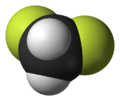Difluoromethane
| |||
| Names | |||
|---|---|---|---|
| Preferred IUPAC name
Difluoromethane[1] | |||
| Other names
'R-32
Methylene difluoride | |||
| Identifiers | |||
3D model (JSmol)
|
|||
| Abbreviations | HFC-32 R-32 | ||
| 1730795 | |||
| ChEBI | |||
| ChEMBL | |||
| ChemSpider | |||
| ECHA InfoCard | 100.000.764 | ||
| EC Number |
| ||
| 259463 | |||
| MeSH | Difluoromethane | ||
PubChem CID
|
|||
| RTECS number |
| ||
| UNII | |||
| UN number | 3252 | ||
CompTox Dashboard (EPA)
|
|||
| |||
| |||
| Properties | |||
| CH2F2 | |||
| Molar mass | 52.024 g·mol−1 | ||
| Appearance | Colourless gas | ||
| Density | 1.1 g cm−3(in liquid form) | ||
| Melting point | −136 °C (−213 °F; 137 K) | ||
| Boiling point | −52 °C (−62 °F; 221 K) | ||
| log P | −0.611 | ||
| Vapor pressure | 1,518.92 kPa (220.301 psi) (at 21.1 °C [70.0 °F; 294.2 K]) | ||
| Hazards | |||
| GHS labelling: | |||

| |||
| Danger | |||
| H220 | |||
| P210, P377, P381, P403, P410+P403 | |||
| NFPA 704 (fire diamond) | |||
| 648 °C (1,198 °F; 921 K) | |||
| Safety data sheet (SDS) | MSDS at Oxford University | ||
Except where otherwise noted, data are given for materials in their standard state (at 25 °C [77 °F], 100 kPa).
| |||
Difluoromethane, also called HFC-32 is an organofluorine compound with the formula CH2F2. It is a colorless gas that is used as a refrigerant.

Synthesis
[edit]Difluoromethane is produced by the reaction of dichloromethane and hydrogen fluoride (HF) using SbF5 as a catalyst.[2]
- CH2Cl2 + 2 HF → CH2F2 + 2 HCl
Applications
[edit]Difluoromethane is used as refrigerant that has prominent heat transfer and pressure drop performance, both in condensation and vaporization.[3]
Difluoromethane is currently used by itself in residential and commercial air-conditioners in Japan, China, and India as a substitute for R-410A. In order to reduce the residual risk associated with its mild flammability, this molecule should be applied in heat transfer equipment with low refrigerant charge such as brazed plate heat exchangers (BPHE), or shell and tube heat exchangers and tube and plate heat exchangers with tube of small diameter.[4] Many applications confirmed that difluoromethane exhibits heat transfer coefficients higher than those of R-410A under the same operating conditions but also higher frictional pressure drops.[4]
Other uses of difluoromethane include its use as aerosol propellant and blowing agent.
Environmental effects
[edit]The global warming potential (GWP) of HFC-32 is estimated at 677 on a 100-year time window.[5] This is far lower than the GWP for HFC refrigerants it is replacing, but remains sufficiently high to spur continued research into using lower-GWP refrigerants.
Difluoromethane is excluded from the list of VOCs supplied in the United States Clean Air Act due to the ODP being zero.[5]
References
[edit]- ^ "Difluoromethane - Compound Summary". The PubChem Project. US: National Center of Biotechnological Information.
- ^ Siegemund, Günter; Schwertfeger, Werner; Feiring, Andrew; Smart, Bruce; Behr, Fred; Vogel, Herward; McKusick, Blaine (2000). "Fluorine Compounds, Organic". Ullmann's Encyclopedia of Industrial Chemistry. doi:10.1002/14356007.a11_349. ISBN 978-3-527-30385-4.
- ^ Longo, Giovanni A.; Mancin, Simone; Righetti, Giulia; Zilio, Claudio (2015). "HFC32 vaporisation inside a Brazed Plate Heat Exchanger (BPHE): Experimental measurements and IR thermography analysis". International Journal of Refrigeration. 57: 77–86. doi:10.1016/j.ijrefrig.2015.04.017.
- ^ a b Longo, Giovanni A.; Mancin, Simone; Righetti, Giulia; Zilio, Claudio (2016). "HFC32 and HFC410A flow boiling inside a 4 mm horizontal smooth tube". International Journal of Refrigeration. 61: 12–22. doi:10.1016/j.ijrefrig.2015.09.002.
- ^ a b Rusch, George M. (2018). "The development of environmentally acceptable fluorocarbons". Critical Reviews in Toxicology. 48 (8): 615–665. doi:10.1080/10408444.2018.1504276. PMID 30474464.
See also
[edit]- R-410A, a refrigerant that is being phased out, and which R-32 is a popular replacement for
- R-454B, another R-410A replacement
- List of refrigerants
External links
[edit]- Flammability Measurements of Difluoromethane in Air at 100 °C Archived 2016-09-20 at the Wayback Machine
- Difluoromethane at Gas Encyclopaedia Archived 2016-03-03 at the Wayback Machine
- IR absorption spectra Archived 2006-10-13 at the Wayback Machine
- SDS Data sheet



